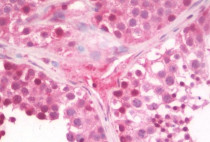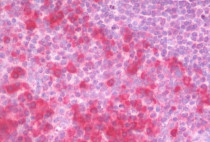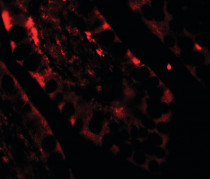ARG42593
anti-CRTC2 / TORC2 antibody
anti-CRTC2 / TORC2 antibody for IHC-Formalin-fixed paraffin-embedded sections,Western blot and Human
Overview
| Product Description | Rabbit Polyclonal antibody recognizes CRTC2 / TORC2 |
|---|---|
| Tested Reactivity | Hu |
| Predict Reactivity | Ms, Rat |
| Tested Application | IHC-P, WB |
| Specificity | Multiple isoforms of CRTC2 are known to exist. This antibody is predicted to not cross-react with CRTC1. |
| Host | Rabbit |
| Clonality | Polyclonal |
| Isotype | IgG |
| Target Name | CRTC2 / TORC2 |
| Antigen Species | Human |
| Immunogen | A 16 amino acid peptide within the last 50 amino acids of Human CRTC2 / TORC2. |
| Conjugation | Un-conjugated |
| Alternate Names | Transducer of CREB protein 2; TORC2; Transducer of regulated cAMP response element-binding protein 2; TORC-2; CREB-regulated transcription coactivator 2 |
Application Instructions
| Application Suggestion |
|
||||||
|---|---|---|---|---|---|---|---|
| Application Note | IHC-P: Antigen Retrieval: Heat mediation. * The dilutions indicate recommended starting dilutions and the optimal dilutions or concentrations should be determined by the scientist. |
||||||
| Positive Control | Human small intestine | ||||||
| Observed Size | ~ 71 kDa |
Properties
| Form | Liquid |
|---|---|
| Purification | Affinity purification with immunogen. |
| Buffer | PBS and 0.02% Sodium azide. |
| Preservative | 0.02% Sodium azide |
| Concentration | 1 mg/ml |
| Storage Instruction | For continuous use, store undiluted antibody at 2-8°C for up to a week. For long-term storage, aliquot and store at -20°C or below. Storage in frost free freezers is not recommended. Avoid repeated freeze/thaw cycles. Suggest spin the vial prior to opening. The antibody solution should be gently mixed before use. |
| Note | For laboratory research only, not for drug, diagnostic or other use. |
Bioinformation
| Database Links |
Swiss-port # Q53ET0 Human CREB-regulated transcription coactivator 2 |
|---|---|
| Gene Symbol | CRTC2 |
| Gene Full Name | CREB regulated transcription coactivator 2 |
| Background | This gene encodes a member of the transducers of regulated cAMP response element-binding protein activity family of transcription coactivators. These proteins promote the transcription of genes targeted by the cAMP response element-binding protein, and therefore play an important role in many cellular processes. Under basal conditions the encoded protein is phosphorylated by AMP-activated protein kinase or the salt-inducible kinases and is sequestered in the cytoplasm. Upon activation by elevated cAMP or calcium, the encoded protein translocates to the nucleus and increases target gene expression. Single nucleotide polymorphisms in this gene may increase the risk of type 2 diabetes. A pseudogene of this gene is located on the long arm of chromosome 5. [provided by RefSeq, Dec 2010] |
| Function | Transcriptional coactivator for CREB1 which activates transcription through both consensus and variant cAMP response element (CRE) sites. Acts as a coactivator, in the SIK/TORC signaling pathway, being active when dephosphorylated and acts independently of CREB1 'Ser-133' phosphorylation. Enhances the interaction of CREB1 with TAF4. Regulates gluconeogenesis as a component of the LKB1/AMPK/TORC2 signaling pathway. Regulates the expression of specific genes such as the steroidogenic gene, StAR. Potent coactivator of PPARGC1A and inducer of mitochondrial biogenesis in muscle cells. Also coactivator for TAX activation of the human T-cell leukemia virus type 1 (HTLV-1) long terminal repeats (LTR). [UniProt] |
| Cellular Localization | Cytoplasm. Nucleus. Note=Translocated from the nucleus to the cytoplasm on interaction of the phosphorylated form with 14-3-3 protein (PubMed:15454081). In response to cAMP levels and glucagon, relocated to the nucleus (PubMed:15454081). [UniProt] |
| Calculated MW | 73 kDa |
| PTM | Phosphorylation/dephosphorylation states of Ser-171 are required for regulating transduction of CREB activity. TORCs are inactive when phosphorylated, and active when dephosphorylated at this site. This primary site of phosphorylation, is regulated by cAMP and calcium levels and is dependent on the phosphorylation of SIKs (SIK1 and SIK2) by LKB1. Both insulin and AMPK increase this phosphorylation of CRTC2 while glucagon suppresses it. Phosphorylation at Ser-274 by MARK2 is induced under low glucose conditions and dephosphorylated in response to glucose influx. Phosphorylation at Ser-274 promotes interaction with 14-3-3 proteins and translocation to the cytoplasm. Asymmetric dimethylation of arginine resisues by PRMT6 enhances the association of CRTC2 with CREB on the promoters of gluconeogenic genes. [UniProt] |
Images (4) Click the Picture to Zoom In
-
ARG42593 anti-CRTC2 / TORC2 antibody IHC-P image
Immunohistochemistry: Formalin-fixed and paraffin-embedded Human testis tissue. Antigen Retrieval: Heat mediation. The tissue section was stained with ARG42593 anti-CRTC2 / TORC2 antibody at 10 µg/ml dilution.
-
ARG42593 anti-CRTC2 / TORC2 antibody WB image
Western blot: Human small intestine lysates stained with ARG42593 anti-CRTC2 / TORC2 antibody at 0.5 and 1 µg/ml dilution.
-
ARG42593 anti-CRTC2 / TORC2 antibody IHC-P image
Immunohistochemistry: Formalin-fixed and paraffin-embedded Human tonsil tissue. Antigen Retrieval: Heat mediation. The tissue section was stained with ARG42593 anti-CRTC2 / TORC2 antibody.
-
ARG42593 anti-CRTC2 / TORC2 antibody IHC image
Immunohistochemistry: Human small intestine tissue stained with ARG42593 anti-CRTC2 / TORC2 antibody at 20 µg/ml dilution.









